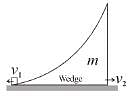All Exams >
Physics >
Mechanics & General Properties of Matter >
All Questions
All questions of Linear Momentum & Energy for Physics Exam
A block attached to a spring, pulled by a constant horizontal force, is kept on a smooth surface as shown in the figure. Initially, the spring is in the natural state. Then the maximum positive work that the applied force F can do is : [Given that spring does not break]
- a)

- b)

- c)∞
- d)

Correct answer is option 'B'. Can you explain this answer?
A block attached to a spring, pulled by a constant horizontal force, is kept on a smooth surface as shown in the figure. Initially, the spring is in the natural state. Then the maximum positive work that the applied force F can do is :
[Given that spring does not break]

a)

b)

c)
∞
d)

|
|
Vedika Singh answered |
Applying work-energy theorem on the block, we get
Fl − kt2/2 = 0
l = 2F/k
or work done = Fl = 2F2/k
Fl − kt2/2 = 0
l = 2F/k
or work done = Fl = 2F2/k
| 1 Crore+ students have signed up on EduRev. Have you? Download the App |
In the figure shown initially spring is in unstretched state and blocks are at rest. Now 100N force is applied on block A and B as shown in figure. After some time velocity of A becomes 2m/s and that of B 4m/s and block A displaced by amount 10cm and spring is stretched by amount 30cm. Then work done by spring force on A will be (in Joule) :
Correct answer is '-6'. Can you explain this answer?
In the figure shown initially spring is in unstretched state and blocks are at rest. Now 100N force is applied on block A and B as shown in figure. After some time velocity of A becomes 2m/s and that of B 4m/s and block A displaced by amount 10cm and spring is stretched by amount 30cm. Then work done by spring force on A will be (in Joule) :

|
|
Vedika Singh answered |

The correct answer is: -6
The spring block system lies on a smooth horizontal surface. The free end of the spring is being pulled towards right with constant speed v0 = 2m/s. At t = 0 sec, the spring of constant k = 100 N/cm in unstretched and the block has a speed 1m/s to left. The maximum extension of the spring is :
- a)8cm
- b)2cm
- c)4cm
- d)6cm
Correct answer is option 'D'. Can you explain this answer?
The spring block system lies on a smooth horizontal surface. The free end of the spring is being pulled towards right with constant speed v0 = 2m/s. At t = 0 sec, the spring of constant k = 100 N/cm in unstretched and the block has a speed 1m/s to left. The maximum extension of the spring is :

a)
8cm
b)
2cm
c)
4cm
d)
6cm
|
|
Vedika Singh answered |
In the frame (inertial w.r.t. earth) of free end of spring, the initial velocity of block is 3 m/s to left and the spring unstretched.

Applying conservation of energy between initial and maximum extension state.
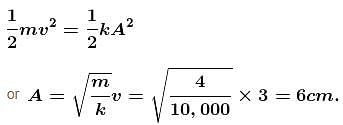
The correct answer is: 6cm
Work done by a force on an rigid object having no rotational motion will be zero, if :- a)the force is always perpendicular to acceleration of object
- b)the object is at rest relative to ground but the point of application of force moves on the object
- c)the force is always perpendicular to velocity of object
- d)the point of application of force is fixed relative to ground but the object moves
Correct answer is option 'B,C'. Can you explain this answer?
Work done by a force on an rigid object having no rotational motion will be zero, if :
a)
the force is always perpendicular to acceleration of object
b)
the object is at rest relative to ground but the point of application of force moves on the object
c)
the force is always perpendicular to velocity of object
d)
the point of application of force is fixed relative to ground but the object moves
|
|
Jayant Mishra answered |
(a) If velocity and acceleration are not in same direction, work done by force perpendicular to acceleration will not be zero.
(b) If the object is at rest no force can do work
(c) If force is perpendicular to velocity work done will be zero
(d) If the point on the body has velocity component in direction of application of force work done will be non-zero.
(b) If the object is at rest no force can do work
(c) If force is perpendicular to velocity work done will be zero
(d) If the point on the body has velocity component in direction of application of force work done will be non-zero.
The correct answers are: the object is at rest relative to ground but the point of application of force moves on the object, the force is always perpendicular to velocity of object
In the figure the variation of components of acceleration of a particle of mass 1kg is shown w.r.t. time. The initial velocity of the particle is  The total work done by the resultant force on the particle in time interval from t = 0 to t = 4 second is :
The total work done by the resultant force on the particle in time interval from t = 0 to t = 4 second is :
- a)22.5J
- b)10J
- c)0
- d)None of these
Correct answer is option 'B'. Can you explain this answer?
In the figure the variation of components of acceleration of a particle of mass 1kg is shown w.r.t. time. The initial velocity of the particle is  The total work done by the resultant force on the particle in time interval from t = 0 to t = 4 second is :
The total work done by the resultant force on the particle in time interval from t = 0 to t = 4 second is :
 The total work done by the resultant force on the particle in time interval from t = 0 to t = 4 second is :
The total work done by the resultant force on the particle in time interval from t = 0 to t = 4 second is :
a)
22.5J
b)
10J
c)
0
d)
None of these
|
|
Jayant Mishra answered |
Your answer is incorrect.
 and
and 




 and
and 




∴ W = 10 J
The correct answer is: 10J
The correct answer is: 10J
The potential energy (in Joules) of a particle of mass 1kg moving in a plane is given by V = 3x + 4y, the position coordinates of the point being x and y, measured in metres. If the particle is at rest at (6,4); then - a)it crosses the y-axis (x = 0) at y = –4
- b)its speed when it crosses the y-axis is 10m/s
- c)its acceleration is of magnitude 5m/s2
- d)it moves in a straight line passing through the origin (0,0)
Correct answer is option 'A,B,C'. Can you explain this answer?
The potential energy (in Joules) of a particle of mass 1kg moving in a plane is given by V = 3x + 4y, the position coordinates of the point being x and y, measured in metres. If the particle is at rest at (6,4); then
a)
it crosses the y-axis (x = 0) at y = –4
b)
its speed when it crosses the y-axis is 10m/s
c)
its acceleration is of magnitude 5m/s2
d)
it moves in a straight line passing through the origin (0,0)
|
|
Vedika Singh answered |
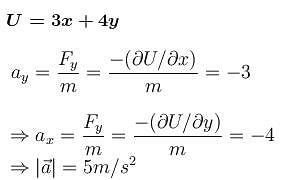
Let at time 't' particle crosses y-axis

⇒ Particle crosses y-axis at y = –4
At (6, 4) U = 34 & KE = 0
At (0, 4); U = –16
⇒ KE = 50

⇒ v = 10 m/s while crossing y-axis
The correct answers are: its acceleration is of magnitude 5m/s2, its speed when it crosses the y-axis is 10m/s, it crosses the y-axis (x = 0) at y = –4
One end of an unstretched vertical spring is attached to the ceiling and an object attached to the other end is slowly lowered to its equilibrium position. If S be gain in spring energy and G be loss in gravitational potential energy in the process, then which of the following is false.- a)S = 2G
- b)S = G
- c)S = 3G
- d)G = 2S
Correct answer is option 'A,B,C'. Can you explain this answer?
One end of an unstretched vertical spring is attached to the ceiling and an object attached to the other end is slowly lowered to its equilibrium position. If S be gain in spring energy and G be loss in gravitational potential energy in the process, then which of the following is false.
a)
S = 2G
b)
S = G
c)
S = 3G
d)
G = 2S
|
|
Vedika Singh answered |
 (loss in gravitationl potential energy)
(loss in gravitationl potential energy)⇒ G = 2S
The correct answers are: S = G, S = 2G, S = 3G
A block of mass m is being pulled up the rough incline by the agent delivering constant power P. The coefficient of friction between the block and the incline is µ. The maximum speed of the block during the courses of ascent is :
- a)

- b)

- c)

- d)

Correct answer is option 'C'. Can you explain this answer?
A block of mass m is being pulled up the rough incline by the agent delivering constant power P. The coefficient of friction between the block and the incline is µ. The maximum speed of the block during the courses of ascent is :

a)

b)

c)

d)

|
|
Vedika Singh answered |
Let at any time the speed of the block along the incline upwards be v.
Then from Newton’s second law
Then from Newton’s second law

the speed is maximum when


The potential energy (in SI units) of a particle of mass 2kg in a conservative fields U = 6x – 8y. If the initial velocity of the particle is  then the total distance traveled by the particle in first two seconds is :
then the total distance traveled by the particle in first two seconds is :- a)15m
- b)12m
- c)10m
- d)18m
Correct answer is option 'A'. Can you explain this answer?
The potential energy (in SI units) of a particle of mass 2kg in a conservative fields U = 6x – 8y. If the initial velocity of the particle is  then the total distance traveled by the particle in first two seconds is :
then the total distance traveled by the particle in first two seconds is :
 then the total distance traveled by the particle in first two seconds is :
then the total distance traveled by the particle in first two seconds is :a)
15m
b)
12m
c)
10m
d)
18m
|
|
Vedika Singh answered |

 has same direction as that of
has same direction as that of 

Since
 are in same direction, particle will move along a straight line
are in same direction, particle will move along a straight line
The correct answer is: 15m
The block of mass m initially at x = 0 is acted upon by a horizontal force at any position x is given as F = a – bx2, where a > μmg, as shown in the figure. The co-efficient of friction between the surfaces of contact is μ. The net work done on the blocks is zero. If the block travels a distance?
- a)

- b)

- c)

- d)None of these
Correct answer is option 'B'. Can you explain this answer?
The block of mass m initially at x = 0 is acted upon by a horizontal force at any position x is given as F = a – bx2, where a > μmg, as shown in the figure. The co-efficient of friction between the surfaces of contact is μ. The net work done on the blocks is zero. If the block travels a distance?

a)

b)

c)

d)
None of these

|
Pie Academy answered |


The correct answer is:

The potential energy of a particle of mass m free to move along x-axis is given by  for x < 0 and U = 0 for x ≥ 0 (x denotes the x-coordinate of the particle and k is a positive constant). If the total mechanical energy of the particle is E, then its speed at
for x < 0 and U = 0 for x ≥ 0 (x denotes the x-coordinate of the particle and k is a positive constant). If the total mechanical energy of the particle is E, then its speed at 
- a)

- b)0
- c)

- d)

Correct answer is option 'B'. Can you explain this answer?
The potential energy of a particle of mass m free to move along x-axis is given by  for x < 0 and U = 0 for x ≥ 0 (x denotes the x-coordinate of the particle and k is a positive constant). If the total mechanical energy of the particle is E, then its speed at
for x < 0 and U = 0 for x ≥ 0 (x denotes the x-coordinate of the particle and k is a positive constant). If the total mechanical energy of the particle is E, then its speed at 
 for x < 0 and U = 0 for x ≥ 0 (x denotes the x-coordinate of the particle and k is a positive constant). If the total mechanical energy of the particle is E, then its speed at
for x < 0 and U = 0 for x ≥ 0 (x denotes the x-coordinate of the particle and k is a positive constant). If the total mechanical energy of the particle is E, then its speed at 
a)

b)
0
c)

d)

|
|
Vedika Singh answered |
From conservation of energy
K.E. + P.E. = E
K.E. + P.E. = E


∴ The speed of particle at
 is zero.
is zero. Power supplied to a particle of mass 2kg varies with time as P =  watt. Here t is time in second. If velocity of particle at t =0sec is v = 0m/s. The velocity of particle (in ms-1) at time t = 2sec will be :
watt. Here t is time in second. If velocity of particle at t =0sec is v = 0m/s. The velocity of particle (in ms-1) at time t = 2sec will be :
Correct answer is '2'. Can you explain this answer?
Power supplied to a particle of mass 2kg varies with time as P =  watt. Here t is time in second. If velocity of particle at t =0sec is v = 0m/s. The velocity of particle (in ms-1) at time t = 2sec will be :
watt. Here t is time in second. If velocity of particle at t =0sec is v = 0m/s. The velocity of particle (in ms-1) at time t = 2sec will be :
 watt. Here t is time in second. If velocity of particle at t =0sec is v = 0m/s. The velocity of particle (in ms-1) at time t = 2sec will be :
watt. Here t is time in second. If velocity of particle at t =0sec is v = 0m/s. The velocity of particle (in ms-1) at time t = 2sec will be :|
|
Vedika Singh answered |
Applying work energy theorem

Solving we get v = 2 m/s
The correct answer is: 2
Work done by static friction on an object :
- a)must be negative
- b)All of these
- c)may be positive
- d)must be zero
Correct answer is option 'B'. Can you explain this answer?
Work done by static friction on an object :
a)
must be negative
b)
All of these
c)
may be positive
d)
must be zero
|
|
Vedika Singh answered |

Consider the blocks shown in the figure to be moving together due to friction between them. The free body diagrams of both the blocks are shown below.

Work done by static friction on A is positive and on B is negative. However, the net work done by static friction is always zero.
A block of mass 2kg is hanging over a smooth and light pulley through a light string. The other end of the string is pulled by a constant force F = 40N. The kinetic energy of the particle increase 40J in a given interval of time. Then : (g = 10m/s2)
- a)tension in the string is 40N
- b)displacement of the block in the given interval of time is 2m
- c)work done by gravity is –20J
- d)work done by tension is 80J
Correct answer is option 'A,B,D'. Can you explain this answer?
A block of mass 2kg is hanging over a smooth and light pulley through a light string. The other end of the string is pulled by a constant force F = 40N. The kinetic energy of the particle increase 40J in a given interval of time. Then : (g = 10m/s2)

a)
tension in the string is 40N
b)
displacement of the block in the given interval of time is 2m
c)
work done by gravity is –20J
d)
work done by tension is 80J
|
|
Jayant Mishra answered |
Free body diagram of block is as shown in figure.
From work-energy theorem
From work-energy theorem

Work done by gravity is


and work done by tension is

The correct answers are: tension in the string is 40N, displacement of the block in the given interval of time is 2m, work done by tension is 80J
Block A is hanging from a vertical spring and is at rest. Block B strikes the block A with velocity v and sticks to it. Then the value of v for which the spring just attains natural length is :
- a)

- b)

- c)

- d)None of these
Correct answer is option 'B'. Can you explain this answer?
Block A is hanging from a vertical spring and is at rest. Block B strikes the block A with velocity v and sticks to it. Then the value of v for which the spring just attains natural length is :

a)

b)

c)

d)
None of these
|
|
Vedika Singh answered |
The initial extension in spring is 
Just after collision of B with A the speed of combined mass is v/2.

Just after collision of B with A the speed of combined mass is v/2.
For the spring to just attain natural length the combined mass must rise up by  (see fig.) and comes to rest.
(see fig.) and comes to rest.
 (see fig.) and comes to rest.
(see fig.) and comes to rest.
Applying conservation of energy between initial and final states.

Alternate solution by SHM

A Person Holds a Bucket by Applying a 10n Force. He Then Moves a Horizontal Distance of 5m and Climbs up a Vertical Distance of 10m. Find out the total work done by him?
Correct answer is '100'. Can you explain this answer?
A Person Holds a Bucket by Applying a 10n Force. He Then Moves a Horizontal Distance of 5m and Climbs up a Vertical Distance of 10m. Find out the total work done by him?
|
|
Pooja Choudhury answered |
s = 5m, F = 10N, and θ = 90°
Work done is given by, W1 = F scos θ = 10 × 5 × cos 90° = 0
In the case of vertical motion, the angle between force and displacement is 0°
Here, F = 10N, s = 10m, and θ=0° So, work done, W2 = 10 × 10 × cos0 = 100J
Therefore, the total work done = W1 + W2 = 100J.
Work done is given by, W1 = F scos θ = 10 × 5 × cos 90° = 0
In the case of vertical motion, the angle between force and displacement is 0°
Here, F = 10N, s = 10m, and θ=0° So, work done, W2 = 10 × 10 × cos0 = 100J
Therefore, the total work done = W1 + W2 = 100J.
In the figure shown initially spring is in unstretched state and blocks are at rest. Now 100N force is applied on block A and B as shown in the figure. After some time velocity of A becomes 2m/s and that of B is 4m/s and block A displaced by amount 10cm and spring is stretched by amount 30cm. Then work done by spring (in Joule) force on A will be :

Correct answer is '-6'. Can you explain this answer?
In the figure shown initially spring is in unstretched state and blocks are at rest. Now 100N force is applied on block A and B as shown in the figure. After some time velocity of A becomes 2m/s and that of B is 4m/s and block A displaced by amount 10cm and spring is stretched by amount 30cm. Then work done by spring (in Joule) force on A will be :


|
|
Jayant Mishra answered |

The correct answer is: -6
An object is moving along a straight line path from P to Q under the action of a force  If the co-ordinate of P and Q in metres are (3, 2, –1) respectively. Then the work done by the force in Joule is :
If the co-ordinate of P and Q in metres are (3, 2, –1) respectively. Then the work done by the force in Joule is :
Correct answer is '15'. Can you explain this answer?
An object is moving along a straight line path from P to Q under the action of a force  If the co-ordinate of P and Q in metres are (3, 2, –1) respectively. Then the work done by the force in Joule is :
If the co-ordinate of P and Q in metres are (3, 2, –1) respectively. Then the work done by the force in Joule is :
 If the co-ordinate of P and Q in metres are (3, 2, –1) respectively. Then the work done by the force in Joule is :
If the co-ordinate of P and Q in metres are (3, 2, –1) respectively. Then the work done by the force in Joule is :|
|
Vedika Singh answered |

The correct answer is: 15
In the figure shown the potential energy U of a particle is plotted against its position x from origin. Then which of the following statement is incorrect.

- a)x3 is in stable equilibrium
- b)x2 is in unstable equilibrium
- c)x1 is in stable equilibrium
- d)x2 is in stable equilibrium
Correct answer is option 'A,C,D'. Can you explain this answer?
In the figure shown the potential energy U of a particle is plotted against its position x from origin. Then which of the following statement is incorrect.

a)
x3 is in stable equilibrium
b)
x2 is in unstable equilibrium
c)
x1 is in stable equilibrium
d)
x2 is in stable equilibrium
|
|
Vedika Singh answered |
x - x1 and x = x3 are not equilibrium positions because  at these points. x = x2 is unstable, as U is maximum at this point.
at these points. x = x2 is unstable, as U is maximum at this point.
 at these points. x = x2 is unstable, as U is maximum at this point.
at these points. x = x2 is unstable, as U is maximum at this point.The correct answers are: x1 is in stable equilibrium, x3 is in stable equilibrium, x2 is in unstable equilibrium
A man places a chain (of mass m and length l) on a table slowly. Initially the lower end of the chain just touches the table. The man drops the chain. When half of the chain is in vertical position. The work done by the man in this process is :- a)

- b)

- c)

- d)

Correct answer is option 'D'. Can you explain this answer?
A man places a chain (of mass m and length l) on a table slowly. Initially the lower end of the chain just touches the table. The man drops the chain. When half of the chain is in vertical position. The work done by the man in this process is :
a)

b)

c)

d)

|
|
Jayant Mishra answered |
The work done by man is negative of magnitude of decrease in potential energy of chain


The correct answer is:

A self propelled vehicle of mass m whose engine delivers constant power P has an acceleration a = P/mv (assume that there is no friction). In order to increase its velocity from v1 to v2 the distance it has to travel will be :- a)

- b)

- c)

- d)

Correct answer is option 'B'. Can you explain this answer?
A self propelled vehicle of mass m whose engine delivers constant power P has an acceleration a = P/mv (assume that there is no friction). In order to increase its velocity from v1 to v2 the distance it has to travel will be :
a)

b)

c)

d)


|
Bijoy Patel answered |


The correct answer is:

The blocks of mass m1 = 1kg and m2 = 2kg are connected by a spring, rest on a rough horizontal surface. The spring is unstretched. The spring constant of spring is K = 2N/m. The coefficient of friction between blocks and horizontal surface is μ = 1/2. Now the left block is imparted a velocity u towards right as shown. Then what is the largest value of u (in m/s) such that the block of mass m2 never moves. (Take g = 10 m/s2)
Correct answer is '10'. Can you explain this answer?
The blocks of mass m1 = 1kg and m2 = 2kg are connected by a spring, rest on a rough horizontal surface. The spring is unstretched. The spring constant of spring is K = 2N/m. The coefficient of friction between blocks and horizontal surface is μ = 1/2. Now the left block is imparted a velocity u towards right as shown. Then what is the largest value of u (in m/s) such that the block of mass m2 never moves. (Take g = 10 m/s2)

|
|
Vedika Singh answered |
For the block of mass m2, not to move, the maximum compression in the spring x0 should be such that
kx0 = μm2 .....(i)
Applying work energy theorem to block of mass m1 we get

From equation (1) and (2) we get


putting the appropriate value we get μ = 10m/s.
The correct answer is: 10
A body of mass 5kg is acted upon by a variable force. The force varies with the distance covered by the body. Find the kinetic energy (in Joule) of the body when the body has covered 30m distance? Assume that the body starts from rest.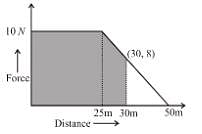
Correct answer is '295'. Can you explain this answer?
A body of mass 5kg is acted upon by a variable force. The force varies with the distance covered by the body. Find the kinetic energy (in Joule) of the body when the body has covered 30m distance? Assume that the body starts from rest.


|
Pie Academy answered |
Work done by force when body has covered 25m
Area under curve upto distance 25m
Area under curve upto distance 25m

Area between 25m to 30m is 
So total work done by variable force till 30m is 250+45 = 295Joule
So, change in kinetic energy = 295J.
So final energy = 295J.
The correct answer is: 295

So total work done by variable force till 30m is 250+45 = 295Joule
So, change in kinetic energy = 295J.
So final energy = 295J.
The correct answer is: 295
The graph between the resistive force F acting on a body and the distance covered by the body is shown in the figure. The mass of the body is 25kg and initial velocity is 2m/s. When the distance covered by the body is 4m, its kinetic energy (in Joule) would be :
Correct answer is '10'. Can you explain this answer?
The graph between the resistive force F acting on a body and the distance covered by the body is shown in the figure. The mass of the body is 25kg and initial velocity is 2m/s. When the distance covered by the body is 4m, its kinetic energy (in Joule) would be :

|
|
Vedika Singh answered |
Area under curve 
W = work done by resistive force F

W = work done by resistive force F

The correct answer is: 10
A man places a chain (of mass m and length l) on a table slowly. Initially the lower end of the chain just touches the table. The man drops the chain. When half of the chain is in vertical position, the potential energy of chain is :- a)

- b)

- c)

- d)

Correct answer is option 'D'. Can you explain this answer?
A man places a chain (of mass m and length l) on a table slowly. Initially the lower end of the chain just touches the table. The man drops the chain. When half of the chain is in vertical position, the potential energy of chain is :
a)

b)

c)

d)


|
Pie Academy answered |
The work done by man is negative of magnitude of decrease in potential energy of chain


The correct answer is: 

In the Figure, the ball A is released from rest when the spring is at its natural length. For the block B of mass M to leave contact with the ground of some stage, the minimum mass of A must be :
- a)2M
- b)M/4
- c)M/2
- d)M
Correct answer is option 'C'. Can you explain this answer?
In the Figure, the ball A is released from rest when the spring is at its natural length. For the block B of mass M to leave contact with the ground of some stage, the minimum mass of A must be :

a)
2M
b)
M/4
c)
M/2
d)
M
|
|
Jayant Mishra answered |
Let m be minimum mass of ball
Let mass A moves downwards by x.
From conservation of energy
Let mass A moves downwards by x.
From conservation of energy

For mass M to leave contact with ground,

The correct answer is: M/2
In the given figure, the magnitude of work done by frictional force on upper and lower block?
Correct answer is '40'. Can you explain this answer?
In the given figure, the magnitude of work done by frictional force on upper and lower block?


|
Pie Academy answered |
Assume 20kg and 30kg block move together


∴ friction force on 20kg block is f = 20 × 1 = 20N
The maximum value of frictional force is 
Hence no slipping is occurring.

Hence no slipping is occurring.
∴ The value of frictional force is f = 20N
Distance traveled in t = 2 seconds.
 Work done by frictional force on upper block is
Work done by frictional force on upper block is Wfriction = 20 × 2 = 40J
Work done by friction force on lower block is = –20 × 2 = –40J.
The correct answer is: 40
A fire hose has a diameter of 2.5cm and is required to direct a jet of water to a height of at least 40m. The minimum power (in kW) of the pump needed for this hose is :
Correct answer is '2.15'. Can you explain this answer?
A fire hose has a diameter of 2.5cm and is required to direct a jet of water to a height of at least 40m. The minimum power (in kW) of the pump needed for this hose is :
|
|
Vedika Singh answered |
The speed of the water leaving the hose must be  if it is to reach a height h when directed vertically upward. If the diameter is d, the volume of water ejected at this speed is
if it is to reach a height h when directed vertically upward. If the diameter is d, the volume of water ejected at this speed is 
 if it is to reach a height h when directed vertically upward. If the diameter is d, the volume of water ejected at this speed is
if it is to reach a height h when directed vertically upward. If the diameter is d, the volume of water ejected at this speed is 
⇒ Mass ejected is 

This kinetic energy of this water leaving the hose

The correct answer is: 2.15
A particle A of mass 10/7 kg is moving in the positive x direction. Its initial position is x = 0 and initial velocity is 1m/s. The velocity (in m/s) at x = 10 is ......... . (use the graph given)
Correct answer is '4'. Can you explain this answer?
A particle A of mass 10/7 kg is moving in the positive x direction. Its initial position is x = 0 and initial velocity is 1m/s. The velocity (in m/s) at x = 10 is ......... .
(use the graph given)

|
|
Vedika Singh answered |
Area under P-x graph

From graph; 



The correct answer is: 4
Which of the following is/are conservative force(s)?- a)

- b)

- c)

- d)

Correct answer is option 'A,B,D'. Can you explain this answer?
Which of the following is/are conservative force(s)?
a)

b)

c)

d)

|
|
Vedika Singh answered |

Clearly for forces  the integration do not require any information of the path taken.
the integration do not require any information of the path taken.
 the integration do not require any information of the path taken.
the integration do not require any information of the path taken.
Taking : x2 + y2 = t
2xdx + 2ydy = dt

which is solvable.
Hence  are conservative forces.
are conservative forces.
 are conservative forces.
are conservative forces.But 
requires some more information on path. Hence non-conservative.
The correct answers are:

requires some more information on path. Hence non-conservative.
The correct answers are:

A block of mass m is attached with a massless spring of force constant k. The block is placed over a fixed rough inclined surface for which the coefficient of friction is μ = 3/4. The block of mass m is initially at rest. The block of mass M is released from rest with spring in unstretched state. The minimum value of M required to move the block up the plane is given by λm Find the value of λ. (neglect mass of string and pulley and friction in pulley.)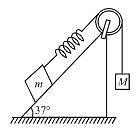
Correct answer is '0.6'. Can you explain this answer?
A block of mass m is attached with a massless spring of force constant k. The block is placed over a fixed rough inclined surface for which the coefficient of friction is μ = 3/4. The block of mass m is initially at rest. The block of mass M is released from rest with spring in unstretched state. The minimum value of M required to move the block up the plane is given by λm Find the value of λ.
(neglect mass of string and pulley and friction in pulley.)

|
|
Vedika Singh answered |
As long as the block of mass m remains stationary, the block of mass M released from rest comes down by  (before coming it rest momentarily again).
(before coming it rest momentarily again).
 (before coming it rest momentarily again).
(before coming it rest momentarily again).Thus the maximum extension in spring is 

for block of mass m to just move up the incline

The correct answer is: 0.6
A particle is projected vertically upwards with a speed of 16m/s, after some time, when it again passes through the point of projection, its speed is found to be 8m/s. It is known that the work done by air resistance is same during upward and downward motion. Then the maximum height (in m) attained by the particle is : (Take g = 10m/s2) :
Correct answer is '8'. Can you explain this answer?
A particle is projected vertically upwards with a speed of 16m/s, after some time, when it again passes through the point of projection, its speed is found to be 8m/s. It is known that the work done by air resistance is same during upward and downward motion. Then the maximum height (in m) attained by the particle is : (Take g = 10m/s2) :
|
|
Vedika Singh answered |
From work energy theorem for upward motion
 (work by air resistance) for downward motion
(work by air resistance) for downward motion 
or h = 8m
The correct answer is: 8
For a particle moving on a straight line the variation of acceleration with time is given by the graph as shown initially the particle was at rest. Then the corresponding kinetic energy of the particle versus time graph will be :

- a)

- b)

- c)

- d)
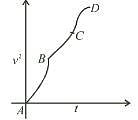
Correct answer is option 'D'. Can you explain this answer?
For a particle moving on a straight line the variation of acceleration with time is given by the graph as shown initially the particle was at rest. Then the corresponding kinetic energy of the particle versus time graph will be :

a)

b)

c)

d)

|
|
Jayant Mishra answered |
The above graphs show v-t graph from a-t graph and then v2-t graph, which are self explanatory.
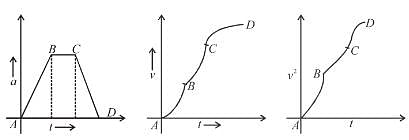
The correct answer is:


There are two massless springs A and B of spring constant KA and KB respectively and KA > KB. If WA and WB be denoted as work done on A and work done on B respectively, then :- a)If they are compressed by same distance, WA = WB
- b)If they are compressed to same distance, WA > WB
- c)If they are compressed by same force (upto equilibrium state) WA < WB
- d)If they are compressed by same force (upto equilibrium state) WA > WB
Correct answer is option 'B,C'. Can you explain this answer?
There are two massless springs A and B of spring constant KA and KB respectively and KA > KB. If WA and WB be denoted as work done on A and work done on B respectively, then :
a)
If they are compressed by same distance, WA = WB
b)
If they are compressed to same distance, WA > WB
c)
If they are compressed by same force (upto equilibrium state) WA < WB
d)
If they are compressed by same force (upto equilibrium state) WA > WB
|
|
Vedika Singh answered |
If the springs are compressed to same amount :

If the springs are compressed by same force.
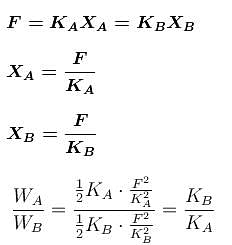
The correct answers are: If they are compressed to same distance, WA > WB, If they are compressed by same force (upto equilibrium state) WA < WB
A block of mass m is attached to two unstretched springs of spring constants k1 and k2 as shown in figure. The block is displaced towards right through a distance x and is released. Find the speed of the block as passes through the means position shown.
- a)

- b)

- c)

- d)

Correct answer is option 'B'. Can you explain this answer?
A block of mass m is attached to two unstretched springs of spring constants k1 and k2 as shown in figure. The block is displaced towards right through a distance x and is released. Find the speed of the block as passes through the means position shown.

a)

b)

c)

d)


|
Pie Academy answered |
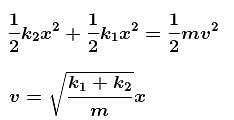
The correct answer is:

The blocks A and B shown in the figure have masses MA = 5kg and MB = 4 kg. The system is released from rest. The speed of B after A has traveled a distance 1 m along the incline is :
- a)

- b)

- c)

- d)

Correct answer is option 'D'. Can you explain this answer?
The blocks A and B shown in the figure have masses MA = 5kg and MB = 4 kg. The system is released from rest. The speed of B after A has traveled a distance 1 m along the incline is :

a)

b)

c)

d)

|
|
Vedika Singh answered |
If A moves down the incline by 1 metre. B shall move up by 1/2 metre. If the speed of B is v then the speed of A will be 2v.
Gain in K.E. = loss in P.E.

Solving, we get

The correct answer is:
Gain in K.E. = loss in P.E.

Solving, we get

The correct answer is:

The potential energy for a force field  is given by U(x, y) = cos(x + y). The force is acting on a particle at position given by coordinates
is given by U(x, y) = cos(x + y). The force is acting on a particle at position given by coordinates  then which of the following statement is true.
then which of the following statement is true.- a)

- b)

- c)

- d)

Correct answer is option 'A,C'. Can you explain this answer?
The potential energy for a force field  is given by U(x, y) = cos(x + y). The force is acting on a particle at position given by coordinates
is given by U(x, y) = cos(x + y). The force is acting on a particle at position given by coordinates  then which of the following statement is true.
then which of the following statement is true.
 is given by U(x, y) = cos(x + y). The force is acting on a particle at position given by coordinates
is given by U(x, y) = cos(x + y). The force is acting on a particle at position given by coordinates  then which of the following statement is true.
then which of the following statement is true.a)

b)

c)

d)

|
|
Jayant Mishra answered |
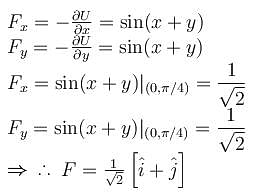
The correct answers are: 

A collar B of mass 2kg is constrained to move along a horizontal smooth and fixed circular track of radius 5m. The spring lying in the plane of the circular track and having spring constant 200N/m is undeformed when the collar is at A. If the collar starts from rest at B the normal reaction exerted by the track on the collar when it passes through A is :
- a)720N
- b)2880N
- c)1440N
- d)360N
Correct answer is option 'C'. Can you explain this answer?
A collar B of mass 2kg is constrained to move along a horizontal smooth and fixed circular track of radius 5m. The spring lying in the plane of the circular track and having spring constant 200N/m is undeformed when the collar is at A. If the collar starts from rest at B the normal reaction exerted by the track on the collar when it passes through A is :

a)
720N
b)
2880N
c)
1440N
d)
360N
|
|
Vedika Singh answered |
Initial extension will be equal to 6 m.
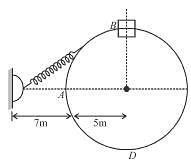



From F.B.D. at A :

The correct answer is: 1440N
A spring lies along an x-axis attached to a wall at one end and a block at the other end. The block rests on a frictionless surface at x = 0. A force of constant magnitude F is applied to the block that begins to compress the spring, until the block comes to a maximum displacement xmax.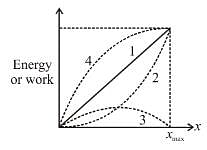 During the displacement, which of the curves shown in the graph best represents the kinetic energy of the block.
During the displacement, which of the curves shown in the graph best represents the kinetic energy of the block.
Correct answer is '3'. Can you explain this answer?
A spring lies along an x-axis attached to a wall at one end and a block at the other end. The block rests on a frictionless surface at x = 0. A force of constant magnitude F is applied to the block that begins to compress the spring, until the block comes to a maximum displacement xmax.

During the displacement, which of the curves shown in the graph best represents the kinetic energy of the block.
|
|
Vedika Singh answered |
Applying W-E theorem on the block for any compression x :

⇒ KE vs x is inverted parabola.
The correct answer is: 3
An engine can pull 4 coaches at a maximum speed of 20m/s. Mass of the engine is twice the mass of every coach. Assuming resistive force to be proportional to the weight. (Power of engine remains constant) :- a)maximum speed of engine when it pulls 12 coaches is 6.5m/s
- b)maximum speed of engine when it pulls 6 coaches is 13m/s
- c)maximum speed of engine when it pulls 6 coaches is 15m/s
- d)maximum speed of engine when it pulls 12 coaches is 8.5m/s
Correct answer is option 'C,D'. Can you explain this answer?
An engine can pull 4 coaches at a maximum speed of 20m/s. Mass of the engine is twice the mass of every coach. Assuming resistive force to be proportional to the weight. (Power of engine remains constant) :
a)
maximum speed of engine when it pulls 12 coaches is 6.5m/s
b)
maximum speed of engine when it pulls 6 coaches is 13m/s
c)
maximum speed of engine when it pulls 6 coaches is 15m/s
d)
maximum speed of engine when it pulls 12 coaches is 8.5m/s

|
Rashi Choudhury answered |
When 4 coaches (m each) are attached with engine (2m)
according to questions P = K 6mgv ...(1)
(constant power), (K being proportionality constant)
Since resistive force is proportional to weight
Now if 12 coaches are attached
according to questions P = K 6mgv ...(1)
(constant power), (K being proportionality constant)
Since resistive force is proportional to weight
Now if 12 coaches are attached
 ...(2)
...(2)Since engine power is constant
So by equation (1) and (2)

So by equation (1) and (2)

Similarly for 6 coaches

The correct answers are: maximum speed of engine when it pulls 12 coaches is 8.5m/s, maximum speed of engine when it pulls 6 coaches is 15m/s
Chapter doubts & questions for Linear Momentum & Energy - Mechanics & General Properties of Matter 2024 is part of Physics exam preparation. The chapters have been prepared according to the Physics exam syllabus. The Chapter doubts & questions, notes, tests & MCQs are made for Physics 2024 Exam. Find important definitions, questions, notes, meanings, examples, exercises, MCQs and online tests here.
Chapter doubts & questions of Linear Momentum & Energy - Mechanics & General Properties of Matter in English & Hindi are available as part of Physics exam.
Download more important topics, notes, lectures and mock test series for Physics Exam by signing up for free.
Mechanics & General Properties of Matter
61 videos|23 docs|25 tests
|
Signup to see your scores go up within 7 days!
Study with 1000+ FREE Docs, Videos & Tests
10M+ students study on EduRev
|
Free Exam Preparation
at your Fingertips!
Access Free Study Material - Test Series, Structured Courses, Free Videos & Study Notes and Prepare for Your Exam With Ease

 Join the 10M+ students on EduRev
Join the 10M+ students on EduRev
|

|
Forgot Password
OR
Signup to see your scores
go up within 7 days!
Access 1000+ FREE Docs, Videos and Tests
Takes less than 10 seconds to signup




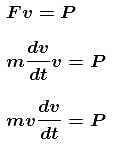

 where A is a constant and x and y in meters around the path shown is :
where A is a constant and x and y in meters around the path shown is : 



 with the vertical. Neglecting friction, its potential energy at the highest point will be :
with the vertical. Neglecting friction, its potential energy at the highest point will be :




 under the influence of a constant force
under the influence of a constant force  The instantaneous power (in Js–1) applied to the particle is :
The instantaneous power (in Js–1) applied to the particle is :
 is given by U(x,y) = sin(x + y). The force acting on the particle of mass m at
is given by U(x,y) = sin(x + y). The force acting on the particle of mass m at 


